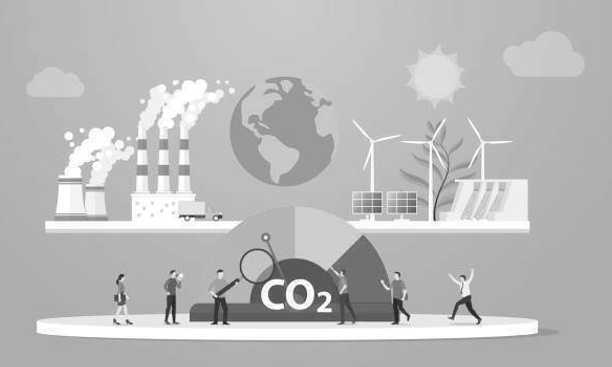The corporate low-carbon strategy: a commitment to a coherent and sustainable transition plan
The consequences of climate change are already being felt, both in France and around the world. Although there is no simple solution to the problems resulting from this upheaval, one thing is certain: human activities are the main cause.
The 6th IPCC report, published in March this year, is unequivocal: reducing greenhouse gas emissions is the only way to halt climate change and mitigate its harmful effects. All existing entities around the world, whether consumers, communities or governments, have the duty and the ability to act. For companies, the carbon footprint is one of the main levers for contributing to the preservation of our planet, as part of an ecological transition plan.
How is a carbon footprint calculated? Why is it crucial to invest in this approach? How can it be put into practice? What complementary but equally essential steps can accompany it?
Corporate carbon footprint: what's it all about?
It is not possible to draw up an effective action plan without first assessing the scale and origins of the CO2 emissions generated. Faced with the need to take concrete action to improve the carbon footprint of all sectors of activity, the French Environment and Energy Management Agency (ADEME), in collaboration with engineer Jean-Marc Jancovici, developed what is known in France as the "Bilan Carbone©" method in 2004. Since 2010, French regulations have followed ADEME's lead, requiring companies to produce their own BEGES (Greenhouse gas emissions report).
Carbon footprint in 2023
As of January 1, 2023, certain companies are legally obliged to carry out a complete carbon footprint covering scopes 1 to 3. This obligation applies to companies with over 500 employees in mainland France and over 250 employees in overseas territories. In the event of non-compliance, these companies incur a €10,000 fine.
Back to the SNBC: France's national low-carbon strategy
In 2015, the French Energy Transition Law for Green Growth (LTECV) introduced the National Low-Carbon Strategy. France's roadmap in response to the Paris Agreements, it sets a clear objective for 2050: to achieve carbon neutrality on a national scale. In other words, to achieve a balance between carbon emissions and the capacity of carbon reservoirs to absorb carbon from the atmosphere. Carbon can be absorbed either by man-managed ecosystems such as forests and agricultural soils, or by industrial processes such as carbon capture, storage or reuse.
The main aim of the SNBC is to provide French companies and citizens with a set of tools designed to help them control their impact on the environment in a progressive but sustainable way.

How is a carbon footprint calculated?
The carbon footprint calculation method takes into account the entire life cycle of the products and services offered by an organization. This approach is in line with ISO 14064 and the GHG Protocol initiative. It covers six gases: carbon dioxide, methane, sulfur hexafluoride, perfluorocarbons, hydrofluorocarbons and nitrous oxide. Because it is based on scopes, the balance takes into account several categories of emissions:
- Company activities (stationary and mobile combustion sources, biomass, etc.)
- Electrical and non-electrical energy consumption
- Freight transport and employee travel, business trips...
- Inputs (purchased products, leased assets, etc.)
- Products sold (manufacture, use and end-of-life)
- All other issues not corresponding to the above categories
Two approaches used to calculate one's carbon footprint
Since data can be expressed in different units, greenhouse gas emissions can be assessed using two distinct approaches:
- The monetary approach, which involves converting a monetary value into equivalent kilograms of CO2 using monetary ratios. This approach is best suited to calculating purchasing-related emissions.
- The physical approach, which involves converting physical data into equivalent kilograms of CO2. This can be applied in particular to car journeys, where emissions are calculated in relation to petrol expenditure.

The benefits and challenges of measuring carbon emissions for businesses
Today, companies must align themselves with national and international objectives in the fight against climate change. By carrying out a carbon footprint, they are adopting a sustainable approach, positioning themselves for the future and adapting to an ever-changing world while meeting ESG criteria.
Meeting stakeholder expectations
Consumers are increasingly concerned (and rightly so) about climate issues. A carbon footprint demonstrates a company's commitment to environmental sustainability, and meets the expectations of its target audience. The notion of carbon footprint is also arousing growing interest among investors, particularly when it comes to tender documents or grant applications.
Meet current legislation
A low-carbon strategy also enables you to meet the latest requirements of the CSRD and CSDD directives, which aim respectively to strengthen the place of sustainable development issues in corporate strategy, governance and risk management, and to integrate human rights and environmental impact into their value chains.
Contributing to non-financial indicators
A low-carbon strategy offers the opportunity to improve extra-financial performance and to have a CSR plan based on solid, quantified foundations. By integrating environmental performance indicators into their CSR plan, companies can track and measure their progress in reducing their carbon footprint, thereby reinforcing their credibility and transparency with stakeholders.
Committing to the fight against global warming
By measuring its carbon footprint, the carbon footprint assessment enables the company to take steps to reduce its impact on the environment. The organization thus becomes an agent of positive change in favor of a better future quality of life on our planet and the preservation of our habitat.
Involving your employees
Carrying out a carbon footprint must necessarily involve employees in raising awareness of the impacts of the company's activities, and encourage them to participate actively in efforts to reduce emissions.
Optimizing costs
Assessing greenhouse gas emissions helps identify the origins of emissions and opportunities for improving energy efficiency. This can lead to long-term financial savings, notably by optimizing energy costs and reducing waste production.

Beyond low-carbon, a Responsible Digital approach integrated into your transition plan
A low-carbon strategy can be summed up in four steps: measure the carbon footprint, create progress indicators, define a strategy and guidelines, and monitor impacts with an adapted solution. While decarbonization is now a key component of corporate transition plans, it is important to emphasize that its scope can be limited. Indeed, today, digital technology, which is inseparable from the activities of companies in all sectors, is the 4th biggest emitter of greenhouse gases.
Beyond the purely environmental aspect, digital use also raises social issues, such as inclusion and accessibility. By adopting an approach that goes beyond the limits of decarbonization and also integrates digital responsibility issues, companies can enrich their transition plan by taking into account their social and societal impacts, and respond to current legislation such as the REEN law. With assessment solutions such as fruggr, a clear, global vision of impacts becomes accessible. They enable you to commit fully to a process of continuous improvement of your digital footprint on the environment and society, making an essential contribution to your transition plan.
